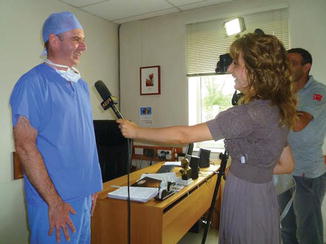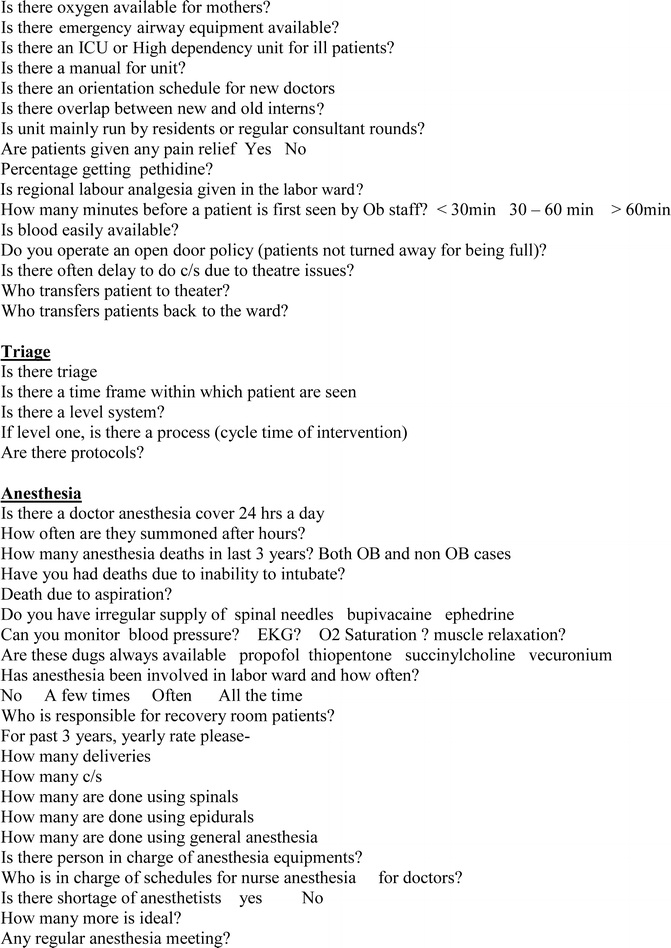
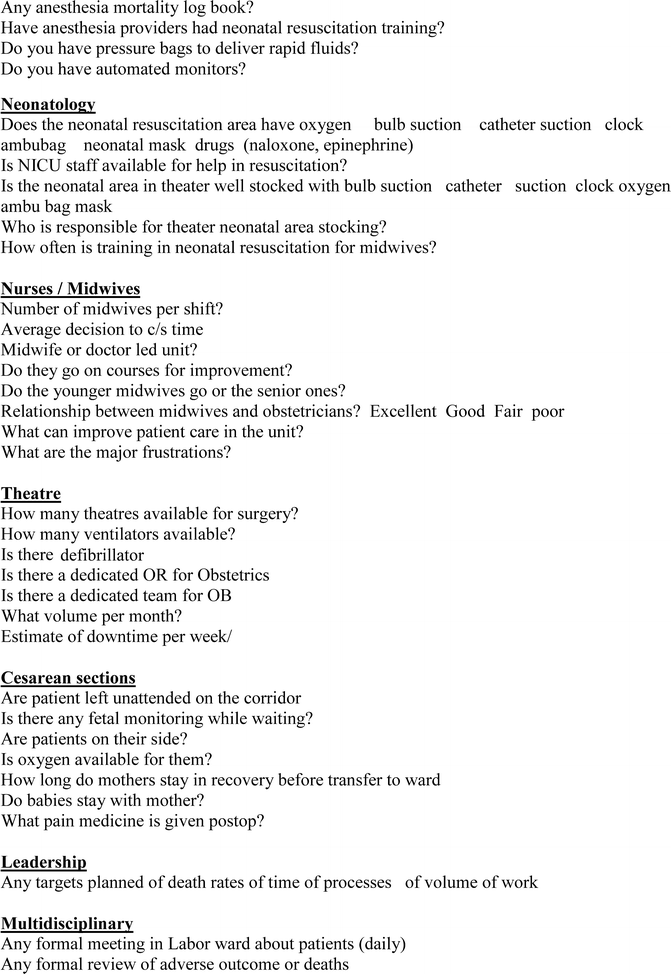
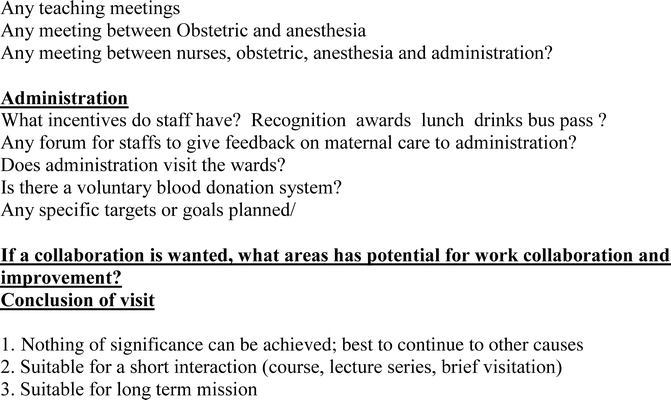
Fig. 5.1
Site assessment form example. These document samples are the property of Kybele, Inc. If you use these or any part of these materials in publication, kindly reference that the materials were developed by Kybele, Inc
During the site visit, one should assess and weigh the competence, influence, and leadership potential of the country host, otherwise deemed “the local champion.” This individual will be pivotal to the overall success of the program and will assist with many elements of planning. A local champion paves the way for understanding local requirements, medical licensure, bureaucracy, legal issues, culture, and lays the groundwork for the program to be successful and well received. He or she must be hardworking and collaborative, with a positive demeanor, and capable of influencing change within their countries. A “local champion” is usually someone not too junior or senior. Young, junior colleagues lack clout within their healthcare systems and often can’t influence change due to hierarchal barriers. Senior colleagues may not have the drive or interest to undertake a time-consuming collaboration due to administrative duties or upcoming retirement. It is very important, however, for senior colleagues to conceptually buy into the program, as they can become stumbling blocks if they are excluded.
One example of a local champion success story is that of Croatian anesthesiologist Dr. Dragica Kopic. One of the authors (MO) was speaking at a medical conference in Croatia and met Dr. Kopic. She was bright, energetic, and interested in learning about obstetric anesthesia but had little experience. Dr. Owen visited her local hospital and made numerous observations. Over the next few months, they continued to communicate via email. They conducted a survey of obstetric anesthesia practices in Croatia and found a limited use of regional anesthesia techniques. Dr. Owen invited her to present her findings at the Society for Obstetric Anesthesia and Perinatology’s annual meeting [7] and sponsored her visit. Dr. Kopic also spent several weeks observing obstetric anesthesia patient care practices at Wake Forest and Duke Universities. Once inspired, her accomplishments were nothing short of remarkable. Within the year of her visit, she introduced into her university hospital the use of regional anesthesia techniques for labor and cesarean section. Prior to this, most patients either had no labor pain relief or general anesthesia for cesarean section. She initiated monthly childbirth education classes for prospective parents (Fig. 5.2). She raised funds to renovate and establish two special labor and delivery rooms—deemed “apartments” in Croatian—to allow a family member to attend the birth, which was previously not permitted. She organized a five-member obstetric anesthesia team among her colleagues and appeared on local television to discuss the merits of epidural analgesia for childbirth. Other hospitals in her region heard about her and started asking for help. To address the growing interest, Drs. Medge Owen and Margaret Sedensky, University of Washington, recruited a 14-member internationally based team of obstetric anesthesiologists, a midwife, and an obstetric internist to travel to Croatia in September 2005 to work within nine university hospitals throughout the country promoting the use of regional anesthesia for obstetric care (Fig. 5.3) [8].
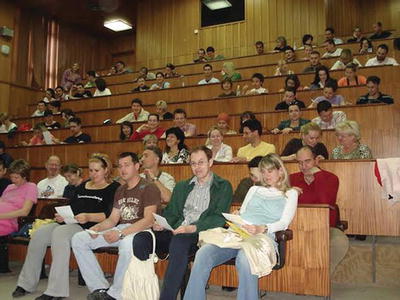


Fig. 5.2
Photo courtesy of Kybele, Inc. Dr. Dragica Kopic leads a family centered educational forum on options for labor pain relief in Split, Croatia

Fig. 5.3
Photo courtesy of Kybele, Inc. Australian anesthesiologist, Dr. Amanda Baric (kneeling front left), with colleagues at Sisak University Hospital, Croatia
Focusing on countries with established anesthesiology training programs is cost-efficient and achieves broad impact because, upon graduation and job placement, young doctors can disseminate and promote new skills across a country [8]. Physicians in training are also quick learners and eager to perform new techniques. The sites selected should have an adequate healthcare infrastructure of supplies, even if there are limitations. Having to continuously bring equipment, medication, and supplies creates a culture of dependency, which cannot be sustained. It is far more useful to provide education to better use the supplies already possessed and to develop internal supply chains through advocacy. This approach may limit projects in some of the poorest countries but unless a country has an established healthcare infrastructure it is unlikely that improvements can be sustained. To illustrate, Kybele conducted a program in the Republic of Georgia from 2006 to 2009 to encourage the use of regional anesthesia techniques for labor analgesia and cesarean section [9]. At the outset of the program, 10 % lidocaine was the only available local anesthetic and regional anesthesia was seldom used. Kybele sought permission from Ministry of Health officials initially to bring bupivacaine, ephedrine, and other supplies into the country for teaching demonstrations. Local physicians saw the immediate benefit of regional anesthesia techniques (Fig. 5.4) and joint advocacy persuaded the Health Ministry to include these medications on the national formulary. As a result, regional anesthesia techniques significantly increased, supply chains improved, and costs for epidural kits and spinal needles decreased across the country [9]. Had Kybele operatives continued to bring in supplies, the vast improvements may have never materialized.


Fig. 5.4
Photo courtesy of Kybele, Inc. Grateful patient with labor analgesia in the Republic of Georgia with Kybele and local medical team
Pre-trip Planning
Once a site has been vetted and the decision to go has been made, pre-trip planning takes center stage. A project should be designed with input from the host physician to fit the specific needs of the country [1, 10]. Often, the host physician networks with other colleagues to determine interest within one or among multiple potential hospital sites. Goals of the trip, the number of participants, and required medical skill sets need to be planned in advance [11]. The local host can arrange housing, local transportation, and obtain permission for visitation and licensure for visitors. Figure 5.5 delineates the general responsibilities for a local host, team leader, and participants in advance of the trip.




Fig. 5.5
Roles and responsibilities. These document samples are the property of Kybele, Inc. If you use these or any part of these materials in publication, kindly reference that the materials were developed by Kybele, Inc.
Trips are often coordinated by one or two team leaders. These are individuals who have demonstrated leadership, flexibility, good judgment, intercultural competency, and strong interpersonal skills along with the requisite traits of superb clinical skills, strong work ethic, and honesty. The team leader or leaders build the team, make sure team members are prepared, and handle problems as they arise during the trip. An orientation packet should be sent to the trip participants approximately 3–4 months prior to departure. This should contain requirements regarding visas, immunizations, medications, and suggestions for travel, what to pack and much more. See Fig. 5.6 for the suggested contents of a pre-trip orientation packet.
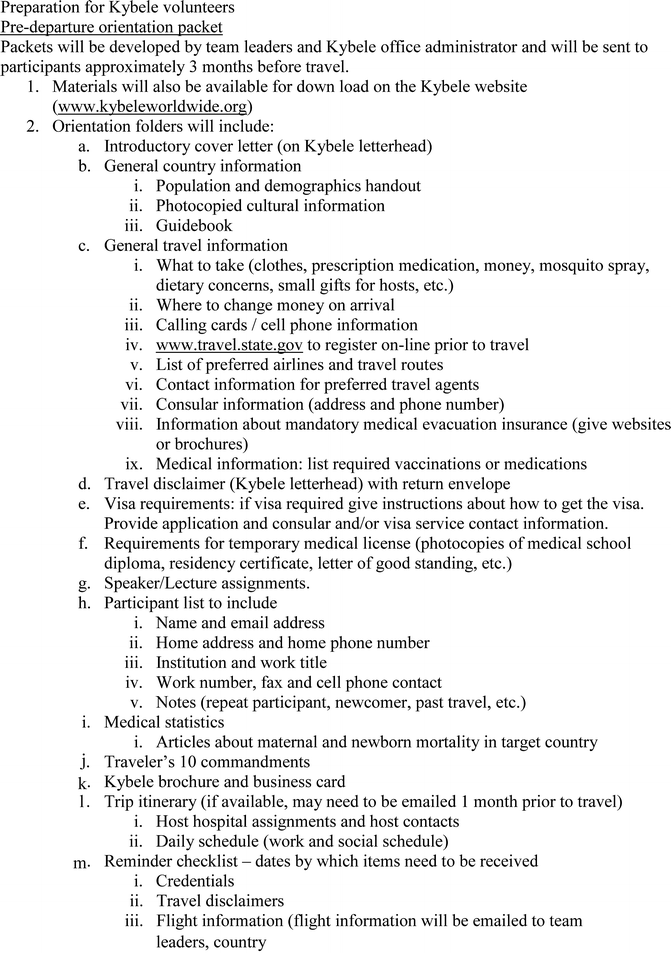
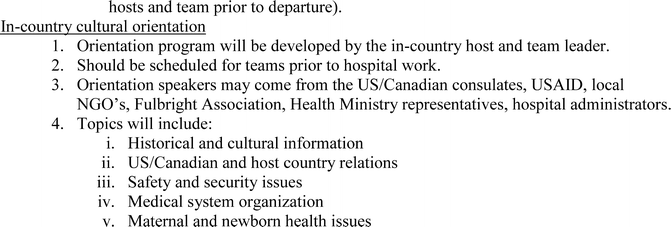


Fig. 5.6
Pre-trip orientation. These document samples are the property of Kybele, Inc. If you use these or any part of these materials in publication, kindly reference that the materials were developed by Kybele, Inc.
Trip Execution
Once in-country, an introductory team meeting should be planned to outline the goals of the trip, roles of participants, and for team members to become acquainted. Orientation should be provided to the team that focuses on the host country culture, particularly as it relates to the practice of medicine, the role of doctors, nurses, and patients. Please see Fig. 5.7 for an example of an in-country orientation session that has been given by Kybele.


Fig. 5.7
In-country orientation. These document samples are the property of Kybele, Inc. If you use these or any part of these materials in publication, kindly reference that the materials were developed by Kybele, Inc.
The actual trip itself will often present with unexpected glitches and surprises, both good and bad. It is appropriate to follow the “Traveler’s 10 Commandments” (Fig. 5.8) and keep things lighthearted. No matter how much pre-trip research is done, how much vetting of participants, and how well prepared the team leader thinks the group is, there will always be surprises. Flexibility, calmness under pressure, and resourcefulness are important qualities of all participants. While on the trip, participants may need to be reminded that they are representatives of the coordinating organization or institution, and as such, need to exercise professionalism and cultural sensitivity. Particularly on a medical mission trip, the work can be intense and emotionally draining. It is important for trip leaders to assess the individual members participating and provide assistance when needed, to help someone understand a difficult situation. A common practice is to have a session in the evening where people can recount the events of the day and air any particular situations, concerns, or successes. This session also helps to more fully understand a participant, which is very useful for identifying future team leaders and assessing the fit of a particular individual for a specific role in possible future trips. Planning a sight-seeing outing at some point during the trip is fun, culturally enriching, and promotes team building (Fig. 5.9). While not to detract from the medical work at hand, this can give participants a needed break and a time to relax and reflect [1].

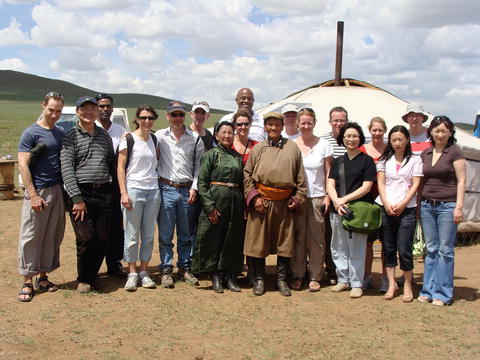

Fig. 5.8
Traveler’s ten commandments

Fig. 5.9
Photo courtesy of Kybele, Inc. Kybele team visits a local gere in Mongolia
When entering a new hospital environment, participants are generally eager to jump right in and get started. Team members should be instructed to avoid this temptation, unless working with Operation Smile or other such organizations where this type of schedule is expected. Regardless of the sponsoring organization, it is important to take the time to observe and to build relationships with the local staff. In some cultures proper introductions to administration and hospital leadership are a prerequisite. Learn the names of colleagues and try to understand the local way of doing things. Western attitudes of superiority or “our way is the best way” should be avoided. It is important to realize that an approach from an institution abroad is not always the right one for the local environment and there can be negative ramifications. Think through situations carefully and make sure any technique being introduced won’t introduce unnecessary expense or potential harm [1, 10]. Try to find creative solutions to local problems through partnership. Neither side has all the answers and mutual understanding can yield the best, innovative results [12, 13]. When building capacity, doing it the right way will undoubtedly take longer, but the outcomes are more likely to be sustained.
As such, teaching must be appropriately tailored to the setting [10]. Bring along a variety of handouts and power point presentations because visitors may be asked to make presentations without much advance notice (Fig. 5.10). Having a laptop is useful but be careful interchanging data across external memory devices as virus protection is often suboptimal. Bringing a textbook or two is also an appreciated gesture that can help for last minute lecture preparation and then be donated to the hospital. If doing clinical demonstrations, it is wise to bring familiar items such as epidural or spinal kits because one doesn’t want to fumble around with unfamiliar supplies and local staff are interested in seeing what is commonly used back home (Fig. 5.11) [9]. Be sure that appropriate permission is granted by authorities to bring medication and supplies into the country, or contents may be seized at the border [1, 9]. Furthermore, it is nice to bring small gifts for those who make the stay special, as well as departmental leaders. It doesn’t need to be expensive and can represent someone’s hometown.
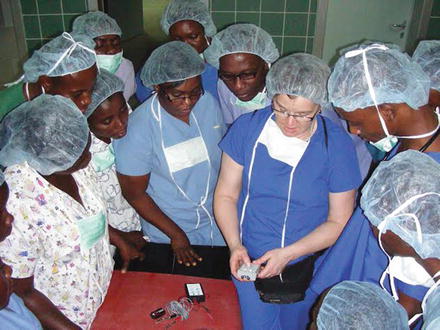
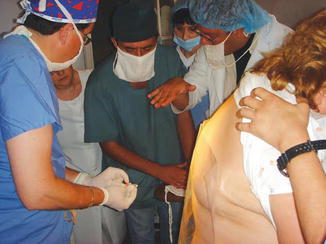

Fig. 5.10
Photo courtesy of Kybele, Inc. Dr. Holly Muir, Duke University Medical Center, engages in a small group tutorial in Ghana

Fig. 5.11
Photo courtesy of Kybele, Inc. Dr. Virgil Manica, TUFTS University, conducts a bedside teaching demonstration in the Republic of Georgia
Media Opportunities
One needs to be prepared should the program become a focus of media attention. This came somewhat unexpectedly during Kybele’s first team excursion to Turkey. Eight obstetric anesthesiologists visited ten teaching hospitals across the country and within 1 week; the program landed on the front page of a major national newspaper with a circulation in the millions. This led the first televised birth, a cesarean section with regional anesthesia, live on prime time national television (excerpts can be viewed at www.kybeleworldwide.org). This demonstrates that improving medical care and healthcare standards are important to the community at large, not just to those behind hospital walls. In fact, nearly every program Kybele has conducted has received print and television coverage (Fig. 5.12), so it is important to hone your message and be prepared [14].
